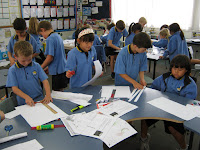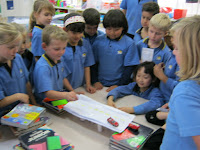WALT: design and build a
prototype bridge.
Problem: A
flood has washed away the bridge across the river between two towns. Your job is to design a new bridge that will
let cars drive from one side of the river to the other.
You can only use the materials provided to make
your bridge.
Success Criteria: Your bridge must be able to hold the weight
of a toy car, and stretch from one side of the river to the other so the car
can be pushed across.
The students were quite excited about this challenge, and then I told them the only materials they could use were paper and sellotape! None the less they attacked the challenge with gusto. Firstly they individually drew bridge designs after seeing some photos on the internet. Then they got into groups and decided which designs, or which features of each others designs, were the best. Then they set to work on making their bridge. By collaborating together and sharing ideas the students were learning to compromise and think of the end result.
Here are some of the original designs:
All the students were working hard to find ways to make their bridges fit the gap and support cars.


After lunch students were given 15 minutes to finish their building projects and then it was testing time. There were some impressive structures and almost all withstood the weight of the car, and were stable enough to stay standing as the cars travelled across the span. Four groups went to show Mrs Sandifer their models and were given Principal Awards stickers for their efforts. Tino Pai Room 19 a great display of collaboration, design and building!












































